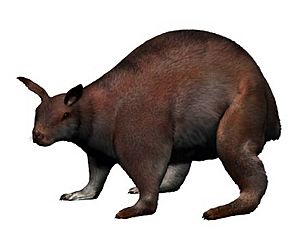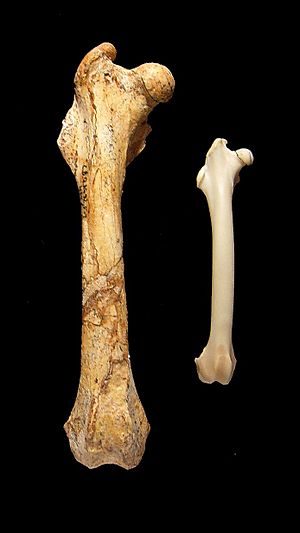Nuralagus facts for kids
Quick facts for kids Nuralagus |
|
|---|---|
 |
|
| Life restoration | |
| Scientific classification | |
| Genus: |
Nuralagus
|
| Species: |
rex
|
Nuralagus is a type of giant rabbit that is now extinct. Its only known species is N. rex. Scientists first described it in 2011.
This amazing creature lived on Menorca, one of the Balearic Islands in the western Mediterranean Sea. It lived during the Pliocene epoch, which was millions of years ago.
Nuralagus rex was the largest lagomorph (a group that includes rabbits, hares, and pikas) ever known. It weighed about 12 kilograms (around 26 pounds). This is almost twice the weight of a large Flemish Giant rabbit! It likely died out when Menorca connected to Mallorca, allowing new animals like the goat-like Myotragus to move into its home.
How We Found Nuralagus
Scientists have found all the fossils of Nuralagus rex in special rock cracks in the northwest of Menorca. These fossils date back to the Pliocene period.
The first descriptions of these fossils were made in 1981. However, the full description, naming the genus and species Nuralagus rex, happened in 2011. This description included the front part of a skull and many other bones from its body.
What Nuralagus Looked Like

Nuralagus rex was about half a meter tall and weighed around 12 kilograms (26 pounds). This makes it the biggest lagomorph ever! It was ten times heavier than a wild European rabbit.
Its huge size was probably due to something called island gigantism. This happens when animals on islands grow much larger than their relatives on the mainland. This is because there are often no predators and plenty of food.
Compared to its body, Nuralagus rex had a small skull. Its sensory receptors, like its eyes and ears, were also small. This suggests it didn't have very good hearing or eyesight.
Unlike modern rabbits, Nuralagus rex had a short, stiff spine. This meant it couldn't jump or move quickly like other rabbits.
The Evolution of Nuralagus
Nuralagus rex likely arrived on what is now Menorca during a time called the Messinian Salinity Crisis. This happened about 5.96 to 5.3 million years ago. During this event, the Strait of Gibraltar closed, causing the Mediterranean Sea to dry up. This connected the islands to the Iberian Peninsula. This allowed the ancestors of Nuralagus to walk to the area.
Later, about 5.3 million years ago, the Zanclean flood refilled the Mediterranean Sea. This isolated the ancestors of Nuralagus on Menorca.
Scientists believe Nuralagus might be related to an extinct group of rabbits called Alilepus. This is because their teeth look similar.
The only other mammal living on Menorca during the Pliocene was a giant dormouse called Muscardinus cyclopeus. Other animals included a giant tortoise, snakes, and lizards.
Nuralagus probably became extinct around the end of the Pliocene. This happened when Menorca and Mallorca connected during times of low sea level. New mammals from Mallorca, like the goat-antelope Myotragus, then moved to Menorca.
The unique features of Nuralagus (like its large size and poor senses) were likely because it lived on an island with no natural predators. Another island rabbit, Pentalagus furnessi, also developed similar traits because it too lived without predators for a long time.
See also
 In Spanish: Conejo gigante de Menorca para niños
In Spanish: Conejo gigante de Menorca para niños


